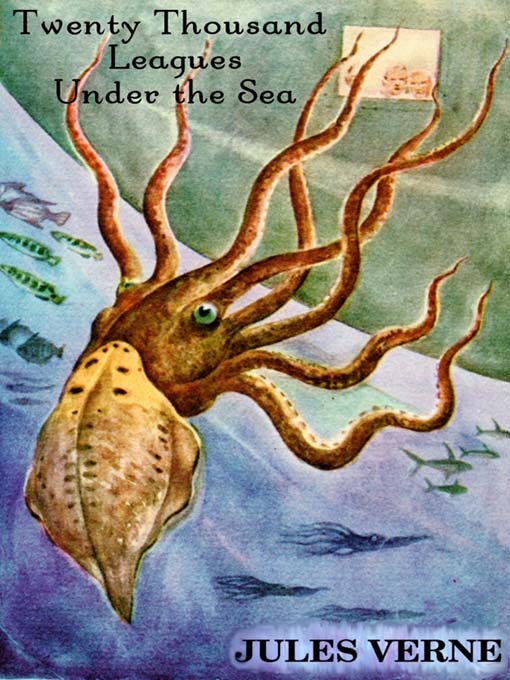 Twenty Thousand Leagues Under the Sea (1870) by Jules Verne: A mysterious sea monster is terrorizing the oceans; an ocean liner is also damaged by the creature. The US government assembles an expedition to destroy the menace. The expedition finds the monster, and the ship charges into battle, but the ship's steering is damaged, and Professor Pierre Aronnax, a marine biologist, his assistant Conseil and Canadian master harpoonist Ned Land are thrown overboard. They find themselves stranded on the "hide" of the creature, only to discover to their surprise that it is a large metal construct. They are quickly captured and brought inside the vessel, where they meet its enigmatic creator and commander, Captain Nemo. Twenty Thousand Leagues Under the Sea (1870) by Jules Verne: A mysterious sea monster is terrorizing the oceans; an ocean liner is also damaged by the creature. The US government assembles an expedition to destroy the menace. The expedition finds the monster, and the ship charges into battle, but the ship's steering is damaged, and Professor Pierre Aronnax, a marine biologist, his assistant Conseil and Canadian master harpoonist Ned Land are thrown overboard. They find themselves stranded on the "hide" of the creature, only to discover to their surprise that it is a large metal construct. They are quickly captured and brought inside the vessel, where they meet its enigmatic creator and commander, Captain Nemo.
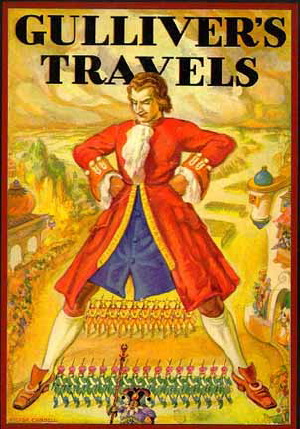 Gulliver's Travels (1726) is a novel by Irish writer and clergyman Jonathan Swift that is both a satire on human nature and a parody of the "travellers' tales" literary sub-genre. It comprises four journeys: (1) A Voyage to Lilliput, where Gulliver is washed ashore after a shipwreck and awakes to find himself a prisoner of a race of people one-twelfth the size of normal human beings. (2) A Voyage to Brobdingnag: Gulliver is abandoned by his companions and found by a farmer who is 72 feet (22 m) tall. (3) A Voyage to Laputa: Gulliver is rescued by the flying island of Laputa, a kingdom devoted to the arts of music and mathematics but utterly unable to use these for practical ends. (4) A Voyage to Houyhnhnms: Gulliver's crew mutiny and abandon him. He comes upon a race of hideous deformed creatures to whom he conceives a violent antipathy. Shortly thereafter he meets a horse and comes to understand that the horses (Houyhnhnm) are the rulers and the deformed creatures ("Yahoos") are human beings in their base form. Gulliver's Travels (1726) is a novel by Irish writer and clergyman Jonathan Swift that is both a satire on human nature and a parody of the "travellers' tales" literary sub-genre. It comprises four journeys: (1) A Voyage to Lilliput, where Gulliver is washed ashore after a shipwreck and awakes to find himself a prisoner of a race of people one-twelfth the size of normal human beings. (2) A Voyage to Brobdingnag: Gulliver is abandoned by his companions and found by a farmer who is 72 feet (22 m) tall. (3) A Voyage to Laputa: Gulliver is rescued by the flying island of Laputa, a kingdom devoted to the arts of music and mathematics but utterly unable to use these for practical ends. (4) A Voyage to Houyhnhnms: Gulliver's crew mutiny and abandon him. He comes upon a race of hideous deformed creatures to whom he conceives a violent antipathy. Shortly thereafter he meets a horse and comes to understand that the horses (Houyhnhnm) are the rulers and the deformed creatures ("Yahoos") are human beings in their base form.
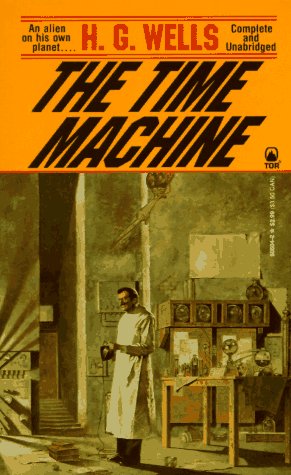 The Time Machine by H G Wells: The book's protagonist is an English scientist and gentleman inventor, identified by a narrator simply as the Time Traveller. The Time Traveller tests his device with a journey that takes him to the year A.D. 802,701, where he meets the Eloi, a society of small, elegant, androgynous, and childlike people. Later, he is approached menacingly by the Morlocks, pale, apelike people who live in darkness underground, where he discovers the machinery and industry that makes the above-ground paradise possible. The Time Machine by H G Wells: The book's protagonist is an English scientist and gentleman inventor, identified by a narrator simply as the Time Traveller. The Time Traveller tests his device with a journey that takes him to the year A.D. 802,701, where he meets the Eloi, a society of small, elegant, androgynous, and childlike people. Later, he is approached menacingly by the Morlocks, pale, apelike people who live in darkness underground, where he discovers the machinery and industry that makes the above-ground paradise possible.
The Black Star Passes by John W Campbell is the first of a science fiction trilogy, the other being Islands of Space and Invaders from the Infinite. The book opens with a million-dollar securities robbery from one of the huge transcontinental aircraft, involving an invisible pirate, suspended-animation gas, and landing a rocket-powered glider atop the monster plane.
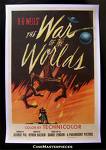 The War of the Worlds (1898) by HG Wells: A journalist struggles to reunite with his wife and brother, while witnessing the Martians destroying Southern English counties and London. Finding London an abandoned ruin, and seeing little hope for humankind, he decides to sacrifice himself to the invaders. The War of the Worlds (1898) by HG Wells: A journalist struggles to reunite with his wife and brother, while witnessing the Martians destroying Southern English counties and London. Finding London an abandoned ruin, and seeing little hope for humankind, he decides to sacrifice himself to the invaders.
 Time Traders by Andre Norton: Time Traders by Andre Norton:
Intelligence agents have uncovered something which seems beyond belief, but the evidence is incontrovertible: the USA's greatest adversary on the world stage is sending its agents back through time!
 Fiddler Fair, by Mercedes Lackey: Learn what happens when animal rights fanatics try to "liberate" genetically reconstructed dinosaurs. Follow Lawrence of Arabia into the desert to meet a power beyond human comprehension; and be with King Arthur, reborn into the present day, when he again gains possession of Excalibur. Fiddler Fair, by Mercedes Lackey: Learn what happens when animal rights fanatics try to "liberate" genetically reconstructed dinosaurs. Follow Lawrence of Arabia into the desert to meet a power beyond human comprehension; and be with King Arthur, reborn into the present day, when he again gains possession of Excalibur.
 A Connecticut Yankee in King Arthur's Court by Mark Twain: The hilarious adventures of Hank Morgan, a 19th-century citizen of Hartford, Connecticut who awakens to find himself inexplicably transported back in time to early medieval England at the time of the legendary King Arthur in AD 528. A Connecticut Yankee in King Arthur's Court by Mark Twain: The hilarious adventures of Hank Morgan, a 19th-century citizen of Hartford, Connecticut who awakens to find himself inexplicably transported back in time to early medieval England at the time of the legendary King Arthur in AD 528.
 Doc Sidhe, by Aaron Allston: Harris Green has hit bottom. His career as a professional kickboxer has gone nowhere, his girlfriend Gwen has dumped him, and he is as drunk as he can be. But when his girlfriend is kidnapped, he ends up in a portal between our own world and the fair world--a place where magic works but where good and evil still battle. Doc Sidhe, by Aaron Allston: Harris Green has hit bottom. His career as a professional kickboxer has gone nowhere, his girlfriend Gwen has dumped him, and he is as drunk as he can be. But when his girlfriend is kidnapped, he ends up in a portal between our own world and the fair world--a place where magic works but where good and evil still battle.
 Neptune Crossing (The Chaos Chronicles, Vol I) by Jeffrey A. Carver: Attached to a research and mining project on Triton, John Bandicut becomes the reluctant "host" of an alien mind who needs him as a vehicle to save Earth from a cosmic catastrophe. The author explores the very real day-to-day problems of playing host to an internal guest. Neptune Crossing (The Chaos Chronicles, Vol I) by Jeffrey A. Carver: Attached to a research and mining project on Triton, John Bandicut becomes the reluctant "host" of an alien mind who needs him as a vehicle to save Earth from a cosmic catastrophe. The author explores the very real day-to-day problems of playing host to an internal guest.
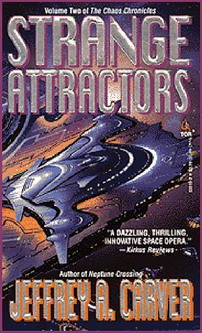 Strange Attractors: (The Chaos Chronicles II) by Jeffrey A. Carver: John Bandicut's close encounter with and possession by an alien intelligence "Charlie" transports him from his galaxy to a distant world on the edge of destruction. Continues the story begun in Neptune Crossing. Strange Attractors: (The Chaos Chronicles II) by Jeffrey A. Carver: John Bandicut's close encounter with and possession by an alien intelligence "Charlie" transports him from his galaxy to a distant world on the edge of destruction. Continues the story begun in Neptune Crossing.
 The Infinite Sea (Chaos Chronicles III) by Jeffrey A. Carver: This hard-science adventure follows, John Bandicut, interstellar troubleshooter; his three alien partners; and two sentient robots to a world made mostly of water. A deadly turbulent force, the Maw of the Abyss, threatens a race of intelligent amphibians who live in an undersea city. The Infinite Sea (Chaos Chronicles III) by Jeffrey A. Carver: This hard-science adventure follows, John Bandicut, interstellar troubleshooter; his three alien partners; and two sentient robots to a world made mostly of water. A deadly turbulent force, the Maw of the Abyss, threatens a race of intelligent amphibians who live in an undersea city.
|
|
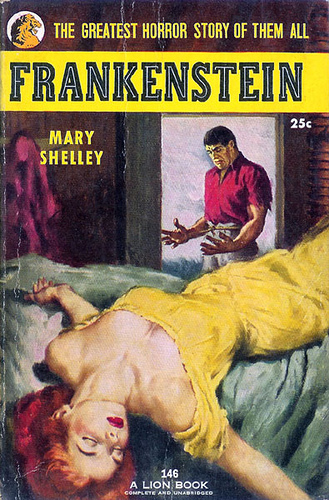 Frankenstein by Mary Shelley Wollstonecraft: Frankenstein by Mary Shelley Wollstonecraft: Frankenstein was raised by a wealthy family, and was always encouraged to seek a greater understanding of the world around him (but not science). At college, however, he discovers the secret to imbuing the inanimate with life, in part by studying how life decays. After giving the monster life, Frankenstein, fearful of the monster's appearance, flees. The monster, on his part, vows revenge at his creator for having created him and then abandoned him. Frankenstein returns home and marries his cousin Elizabeth. In full knowledge of the monster's threat, he prepares for a fight to the death. Frankenstein by Mary Shelley Wollstonecraft: Frankenstein by Mary Shelley Wollstonecraft: Frankenstein was raised by a wealthy family, and was always encouraged to seek a greater understanding of the world around him (but not science). At college, however, he discovers the secret to imbuing the inanimate with life, in part by studying how life decays. After giving the monster life, Frankenstein, fearful of the monster's appearance, flees. The monster, on his part, vows revenge at his creator for having created him and then abandoned him. Frankenstein returns home and marries his cousin Elizabeth. In full knowledge of the monster's threat, he prepares for a fight to the death.
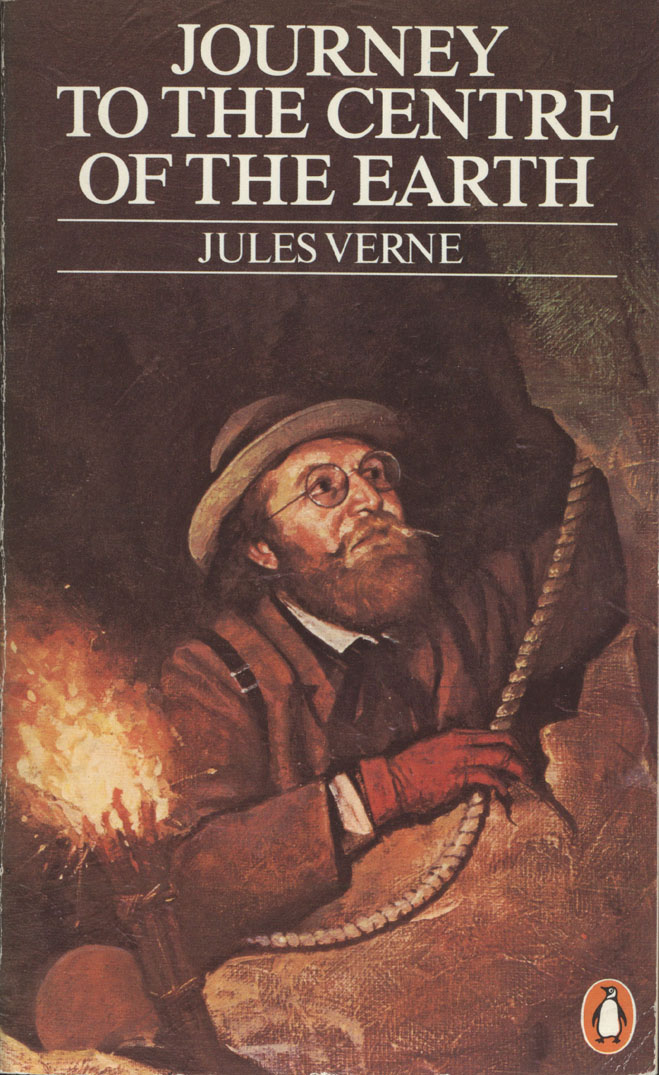 Journey to the Centre of the Earth is a classic 1864 science fiction novel by Jules Verne. The story involves a German professor, Professor Von Hardwigg, who believes there are volcanic tubes going toward the center of the Earth. He, his nephew Axel, and their guide Hans encounter many adventures, including prehistoric animals and natural hazards, eventually coming to the surface again in southern Italy. The living organisms they meet reflect geological time; just as the rock layers become older and older the deeper they travel, the animals become more and more ancient the closer the characters approach the center. Journey to the Centre of the Earth is a classic 1864 science fiction novel by Jules Verne. The story involves a German professor, Professor Von Hardwigg, who believes there are volcanic tubes going toward the center of the Earth. He, his nephew Axel, and their guide Hans encounter many adventures, including prehistoric animals and natural hazards, eventually coming to the surface again in southern Italy. The living organisms they meet reflect geological time; just as the rock layers become older and older the deeper they travel, the animals become more and more ancient the closer the characters approach the center.
 From the Earth to the Moon is a humorous science fantasy novel by Jules Verne and is one of the earliest entries in that genre. It tells the story of a Frenchman and two well-to-do members of a post-American Civil War gun club who build an enormous sky-facing columbiad and launch themselves in a projectile/spaceship from it to a Moon landing. From the Earth to the Moon is a humorous science fantasy novel by Jules Verne and is one of the earliest entries in that genre. It tells the story of a Frenchman and two well-to-do members of a post-American Civil War gun club who build an enormous sky-facing columbiad and launch themselves in a projectile/spaceship from it to a Moon landing.

Star Soldiers: Andre Norton presents a grand tapestry of the far-flung interstellar future, in which the first starships from Earth have burst out into the universe . . . only to run straight into the stagnant alien federation known as Central Control.
 Erewhon, by Samuel Butler: A young traveller discovers Erewhon, and is given a home among its extraordinarily handsome citizens. But their visitor soon discovers that this community has its faults - crime is treated indulgently as a malady, while illness, poverty and misfortune are cruelly punished. Erewhon, by Samuel Butler: A young traveller discovers Erewhon, and is given a home among its extraordinarily handsome citizens. But their visitor soon discovers that this community has its faults - crime is treated indulgently as a malady, while illness, poverty and misfortune are cruelly punished.
 Erewhon Revisited, the sequel to Erewhon, is the story of his return twenty years later to Erewhon to see how his departure in a balloon has affected the culture of the island. Erewhon Revisited, the sequel to Erewhon, is the story of his return twenty years later to Erewhon to see how his departure in a balloon has affected the culture of the island.
 A Voyage to Arcturus: David Lindsay depicts Tormance, an imaginary planet orbiting Arcturus, which, in the novel (not in reality), is a double star consisting of stars Branchspell and Alppain. The lands are used to represent philosophical systems, or states of mind, through which the main character, Maskull, passes on his search for the meaning of life. A Voyage to Arcturus: David Lindsay depicts Tormance, an imaginary planet orbiting Arcturus, which, in the novel (not in reality), is a double star consisting of stars Branchspell and Alppain. The lands are used to represent philosophical systems, or states of mind, through which the main character, Maskull, passes on his search for the meaning of life.
 Gullivar of Mars by Edwin Lester Arnold combines elements of both fantasy and science fiction. It is a precursor and likely inspiration for Edgar Rice Burroughs's classic A Princess of Mars. Both Gullivar and Burroughs's protagonist John Carter are Southern US soldiers who arrive on Mars by magical means and have adventures there, including falling in love with Martian princesses. But unlike John Carter, the hapless Gullivar stumbles in and out of trouble. Gullivar of Mars by Edwin Lester Arnold combines elements of both fantasy and science fiction. It is a precursor and likely inspiration for Edgar Rice Burroughs's classic A Princess of Mars. Both Gullivar and Burroughs's protagonist John Carter are Southern US soldiers who arrive on Mars by magical means and have adventures there, including falling in love with Martian princesses. But unlike John Carter, the hapless Gullivar stumbles in and out of trouble.
 Brave New World, by Aldous Huxley: "Community, Identity, Stability" is the motto of Aldous Huxley's utopian World State. Here everyone consumes daily grams of soma, to fight depression, babies are born in laboratories, and the most popular form of entertainment is a "Feelie," a movie that stimulates the senses of sight, hearing, and touch. Though there is no violence and everyone is provided for, Bernard Marx feels something is missing. Brave New World, by Aldous Huxley: "Community, Identity, Stability" is the motto of Aldous Huxley's utopian World State. Here everyone consumes daily grams of soma, to fight depression, babies are born in laboratories, and the most popular form of entertainment is a "Feelie," a movie that stimulates the senses of sight, hearing, and touch. Though there is no violence and everyone is provided for, Bernard Marx feels something is missing.
 Flatland, by Edwin Abott: The story is about a two-dimensional world referred to as Flatland. The unnamed narrator, a humble square has a dream about a visit to a one-dimensional world (Lineland), and attempts to convince the realm's ignorant monarch of a second dimension. Flatland, by Edwin Abott: The story is about a two-dimensional world referred to as Flatland. The unnamed narrator, a humble square has a dream about a visit to a one-dimensional world (Lineland), and attempts to convince the realm's ignorant monarch of a second dimension.
 A Journey in Other Worlds: by John Jacob Astor IV, 1894. The book offers a fictional account of life in the year 2000. It contains abundant speculation about technological invention, including descriptions of a world-wide telephone network, solar power, air travel, space travel to the planets Saturn and Jupiter, and terraforming engineering projects — damming the Arctic Ocean, and adjusting the Earth's axial tilt (by the Terrestrial Axis Straightening Company). A Journey in Other Worlds: by John Jacob Astor IV, 1894. The book offers a fictional account of life in the year 2000. It contains abundant speculation about technological invention, including descriptions of a world-wide telephone network, solar power, air travel, space travel to the planets Saturn and Jupiter, and terraforming engineering projects — damming the Arctic Ocean, and adjusting the Earth's axial tilt (by the Terrestrial Axis Straightening Company).
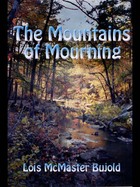 The Mountains of Mourning by Lois McMaster Bujold: Twenty year old Ensign Miles Vorkosigan plays detective in a murder case, and tests the balance of power as a member of the Barrayaran nobility. The Mountains of Mourning by Lois McMaster Bujold: Twenty year old Ensign Miles Vorkosigan plays detective in a murder case, and tests the balance of power as a member of the Barrayaran nobility.
|
 The Infinite Sea (Chaos Chronicles III) by Jeffrey A. Carver: This hard-science adventure follows, John Bandicut, interstellar troubleshooter; his three alien partners; and two sentient robots to a world made mostly of water. A deadly turbulent force, the Maw of the Abyss, threatens a race of intelligent amphibians who live in an undersea city.
The Infinite Sea (Chaos Chronicles III) by Jeffrey A. Carver: This hard-science adventure follows, John Bandicut, interstellar troubleshooter; his three alien partners; and two sentient robots to a world made mostly of water. A deadly turbulent force, the Maw of the Abyss, threatens a race of intelligent amphibians who live in an undersea city.
 Erewhon Revisited, the sequel to Erewhon, is the story of his return twenty years later to Erewhon to see how his departure in a balloon has affected the culture of the island.
Erewhon Revisited, the sequel to Erewhon, is the story of his return twenty years later to Erewhon to see how his departure in a balloon has affected the culture of the island.  Twenty Thousand Leagues Under the Sea
Twenty Thousand Leagues Under the Sea Gulliver's Travels
Gulliver's Travels The Time Machine
The Time Machine  The War of the Worlds (1898) by HG Wells
The War of the Worlds (1898) by HG Wells Time Traders
Time Traders
 A Connecticut Yankee in King Arthur's Court
A Connecticut Yankee in King Arthur's Court  Doc Sidhe,
Doc Sidhe,


 Frankenstein
Frankenstein  Journey to the Centre of the Earth
Journey to the Centre of the Earth  From the Earth to the Moon
From the Earth to the Moon
 Erewhon,
Erewhon,  A Voyage to Arcturus:
A Voyage to Arcturus: Gullivar of Mars
Gullivar of Mars

 A Journey in Other Worlds:
A Journey in Other Worlds: